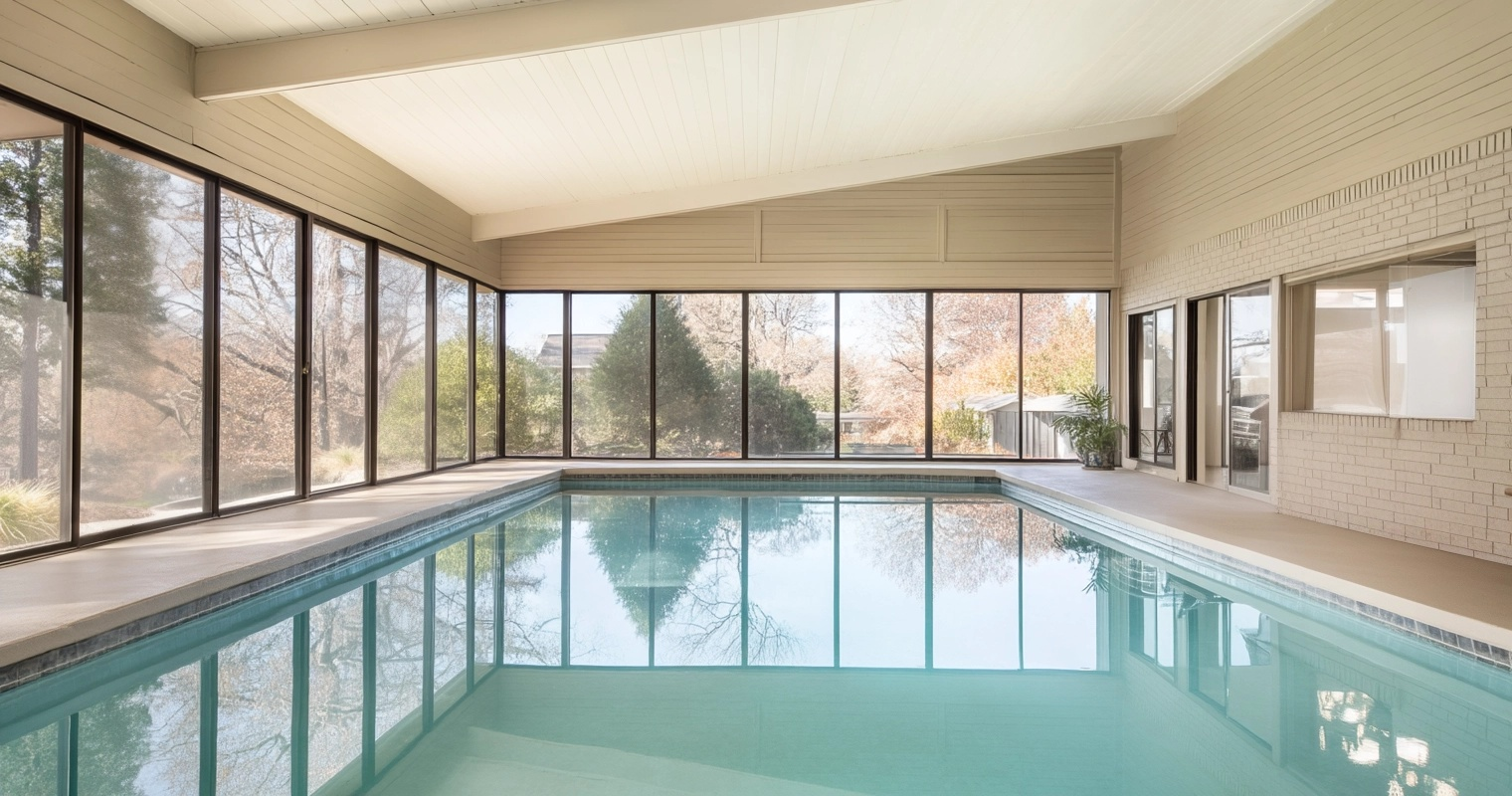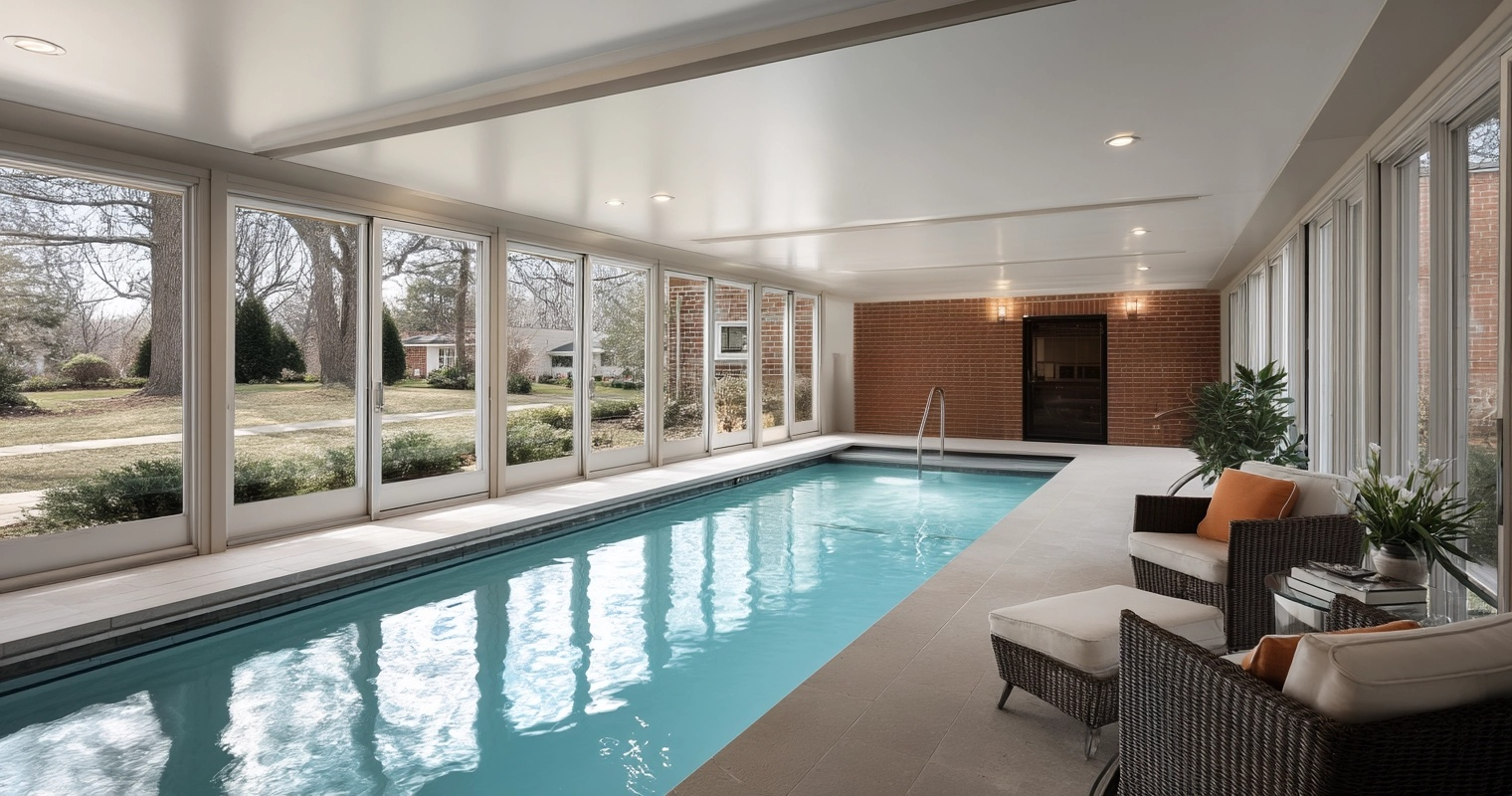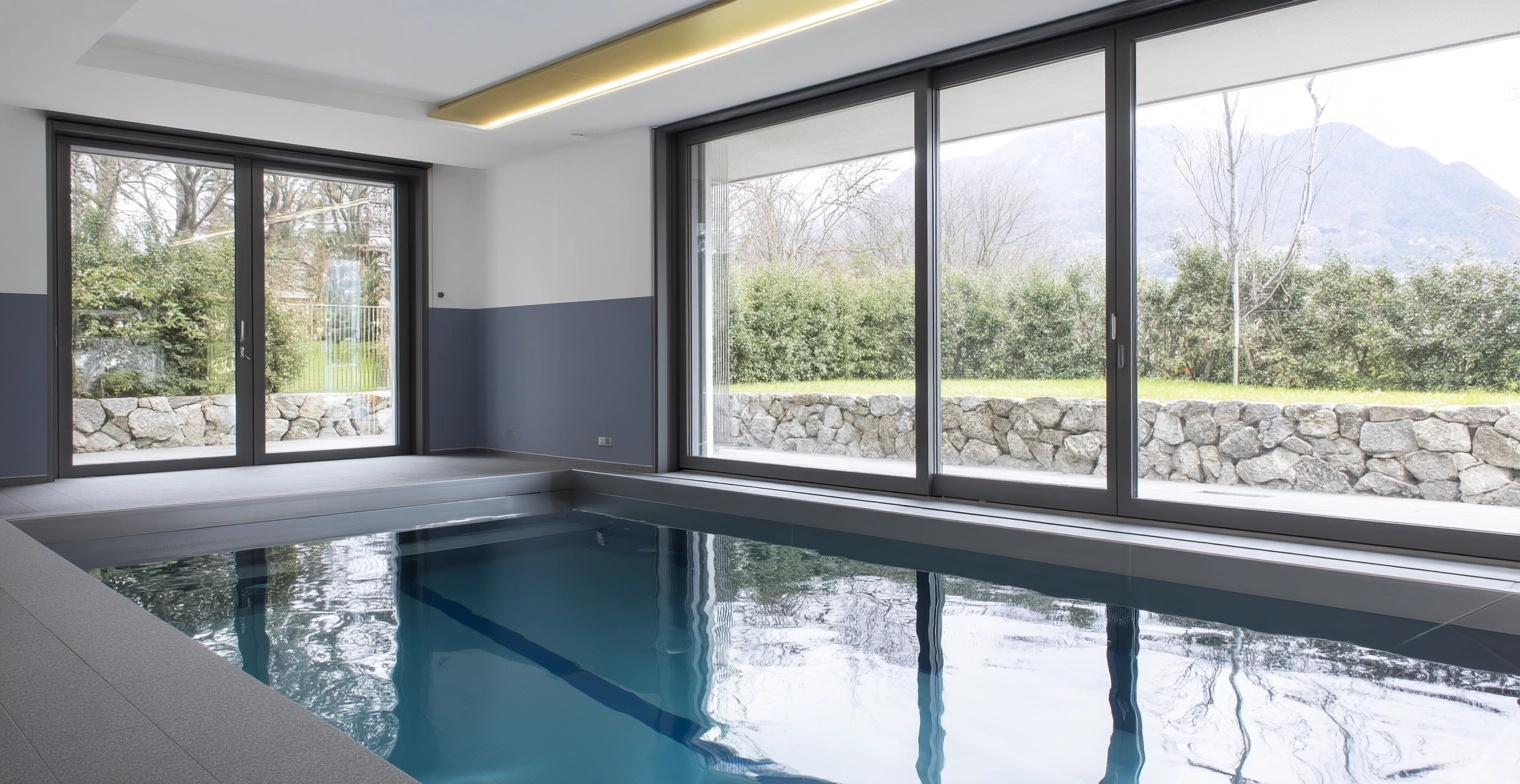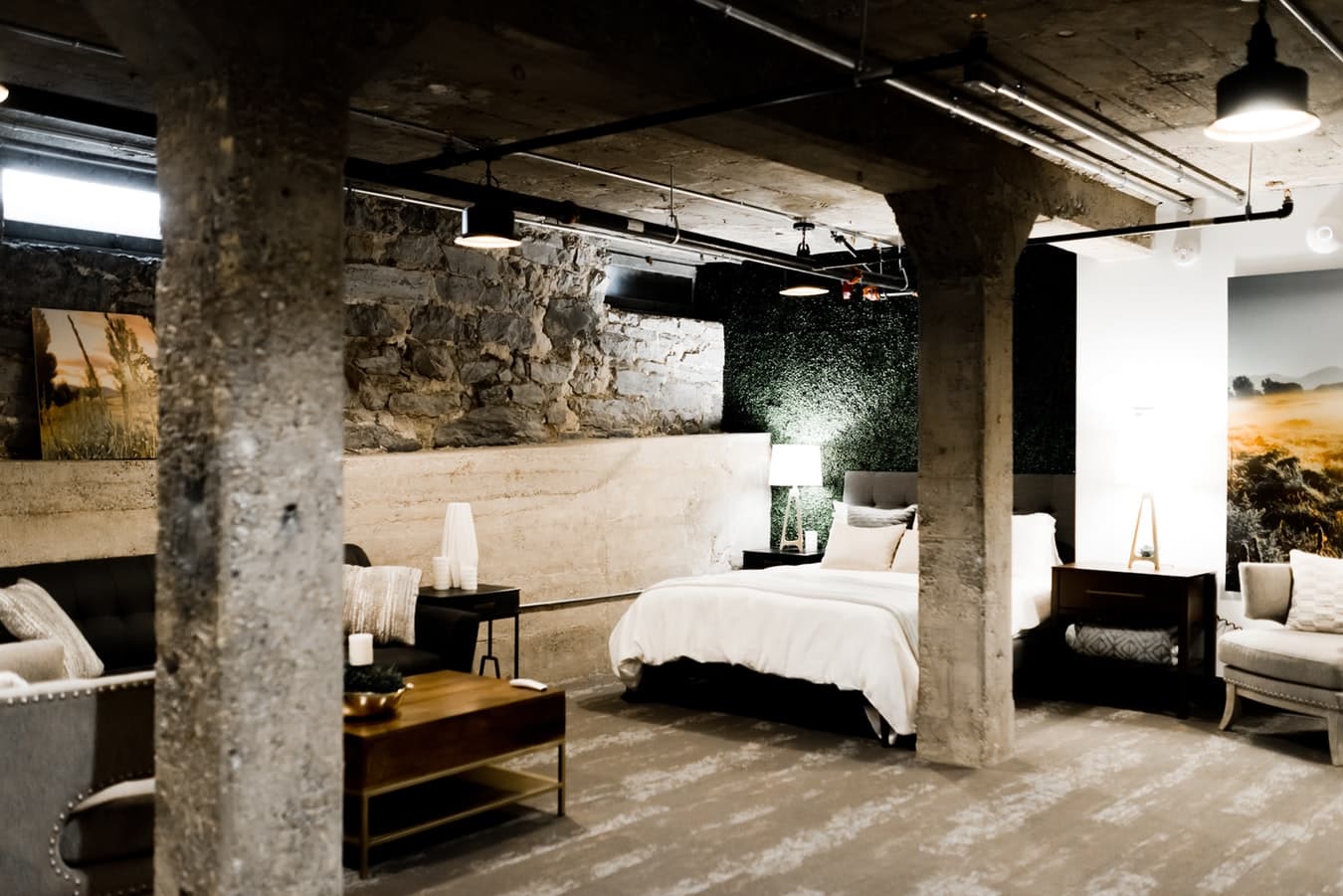Residential Indoor Pools - What should you know before building one?
By Editorial Team
Updated on June 26, 2025

Luxury, privilege, beauty, a warm cocoon in the cold of a Quebec winter—an indoor residential pool is all of this and more. That is why it remains a dream for many of us.
Being able to swim in privacy, at any time, is one of the main reasons the more affluent choose to invest in a residential indoor swimming pool. However, this pleasure comes at a cost, from construction to maintenance.
Price and Advantages of Building a Swimming Pool Inside Your Home

Source : Soumission Rénovation
An indoor pool ensures you can swim year-round. Say goodbye to the annual trip to Florida—with an indoor swimming pool, you can spend the winter at home in a luxurious, comfortably heated environment, perfect for ultimate relaxation in the evenings.
It also increases the value of your home while reducing the risk of legal liability due to insufficient pool security. Since the pool is indoors, barriers and other safety devices are not required. Not only that, but it also provides complete privacy!
However, consider the safety of your loved ones by covering your indoor pool with a protective cover. The most vulnerable groups are children aged 0-4 (42% of drownings) and adults over 75 (17% of victims).
As for the cost, it largely depends on the stage of construction of your home. If your house has not yet been built, the indoor swimming pool can be planned while digging the foundation.
On the other hand, if you want to install an indoor pool in an existing home, it is often best to dig the pool outside first and then construct a building extension to enclose it.
Such a project costs approximately $100,000, plus an additional $50,000 or more for a ventilation system suited to the pool’s size. We will discuss this system in the next section.
How to build an indoor pool in a home?

Source : Soumission Rénovation
Regardless of the type of indoor pool you choose, all share a common trait: they are large, water-filled structures requiring serious maintenance to prevent the growth of bacteria, spores, and mould.
The key component of a pool—its very reason for existing—is water. Water can erode a home's foundation and weaken any container, shell, or concrete structure.
Therefore, before digging your indoor pool, you must determine the type of material that will contain the water:
Fibreglass
Resin, polyester, or acrylic shell
Concrete
Vinyl
Raised pool
Some materials offer more design and size flexibility than others, affecting the shape of the excavation required.
Now that we’ve covered materials, let’s examine how a pool functions so that you understand the construction stages for your residential indoor pool.
Here are the construction steps.
Step 1: Excavation
This step can be challenging depending on your situation:
Your house is not yet built.
You want to extend your existing house.
You want the pool in your basement.
In the first two cases, excavation is straightforward with a mechanical digger. However, if you are digging in a basement, such machinery likely cannot be used, meaning manual labour with a shovel and wheelbarrow is required.
If you plan to build the pool just outside your home and cover it with an extension, maintain a minimum distance of 10 feet between the house and the pool.
An indoor pool can present various challenges, and only a professional can properly advise you on potential risks, such as:
Destabilizing the home’s foundation (do not dig deeper than 1.5 metres).
Installing the pool in a poorly insulated room (maintenance product odours, humidity, noise issues, etc.).
Inadequate ventilation (leading to mould and mildew growth).
Step 2: Pool Installation
Once the hole is dug, the chosen pool structure (fibreglass shell, resin, or concrete) must be installed.
Manufacturers typically deliver a self-supporting concrete structure or just the framework. Once the pool is in place, the space between the pool and the house’s foundation can be filled with sand and compacted to ensure stability.
Step 3: Drainage System
A drainage system, connected to your home’s water disposal network, will help regulate the pool’s water level and renewal process.
Step 4: Interior Lining
Avoid using a vinyl liner for an indoor pool, as continuous heating will degrade the material. Instead, opt for a reinforced PVC membrane with polyester mesh or ceramic tiles.
Step 5: Ventilation
One of the most overlooked aspects of an indoor pool is ventilation. A ventilation system can be as costly as the pool and the building that houses it.
Without proper ventilation to remove excess humidity, mould and mildew will develop on your walls. A high-performance dehumidifier costs between $20,000 and $40,000, depending on the pool's size. The room’s humidity level should never exceed 70%.
Step 6: Technical Room
This room houses all essential equipment for the pool’s operation and maintenance:
Pump
Filters
Plumbing
Heating system
Ventilation system
These components are noisy, so proper insulation is necessary to prevent noise pollution throughout the house.
Step 7: Tile Installation
Like public pools, the flooring in your pool area should be tiled. Ceramic tiles are easy to clean, helping maintain a hygienic environment and simplifying maintenance.
How does an indoor pool work?

Source : Soumission Rénovation
Often, the image we have of an indoor pool is that of still water, waiting for swimmers to set it in motion. The reality is quite the opposite. The water in an indoor pool is constantly moving as it flows through the pipes and filters that make up its filtration system.
To create a functional system, you need at least two drains, which are placed at the deepest point of your pool, much like the drain in a bathtub.
Why a second drain, or even a third? Because the mass of water in a residential indoor swimming pool can be so strong that a single drain may create a vortex when draining the water. According to the INSPQ, this whirlpool effect can be powerful enough to pull a child to the bottom of the pool, posing a drowning risk.
This is why modern drainage systems are equipped with anti-vortex floor drains.
A pool is also a place where debris accumulates. Even in an indoor pool, there are always insects, dead skin, and stray hairs floating on the water. For this reason, you need a wall-mounted skimmer to filter out these elements.
All these pipes lead to a pump, which processes the filtered water before sending it back into the pool through the return jet. Altogether, this circuit can measure up to 49 feet.
Regulations for Indoor Pool Construction
An indoor pool has a legal advantage: since it is inside, no surrounding fence is required. However, any door leading to the pool must automatically close and lock.
Before construction, you must obtain a municipal permit. Each locality has different rules, and even within cities like Montreal, requirements can vary by borough. Contact your local authorities for specific regulations.
Some municipalities require an inspection to ensure compliance, particularly concerning water mass safety.
Water Treatment for an Indoor Pool
To maintain water quality, you can use chlorine or bromine. However, a chemical reaction known as bromine or chloramine formation may occur, irritating swimmers’ eyes and producing a strong odour.
Another option is a saltwater chlorination system. The pool water is salinated at approximately 5 grams of salt per litre—compared to seawater, which contains about 34.7 grams per litre. A cell electrolyzes the salt, generating chlorine, which then reverts back to salt, creating a continuous cycle.
FAQ
Is an indoor residential pool taxable?
In Quebec, renovations that are considered substantial improvements—such as adding new structures or increasing property value—are subject to GST and QST. Minor repairs and maintenance are generally exempt. In other words, yes, an indoor pool is taxable.
Do I need to declare an indoor pool?
Yes, in Quebec, an indoor swimming pool must typically be declared, as it affects property value and may impact property taxes. If the pool is part of a renovation, you should inform your municipality since it may trigger a reassessment of your property value.
What is the average cost of heating an indoor swimming pool?
The average cost of heating a pool depends on the type of system used. Electric heating costs between $100 and $600 per month, while natural gas or propane heating ranges from $200 to $400 per month, though it is a less eco-friendly option. Heat pumps are more cost-effective, ranging from $50 to $200 per month, but they heat the water more slowly. Finally, solar heating is the most cost-efficient option in the long run, with nearly zero monthly costs ($0 to $10), but it requires a higher initial investment.
Is a swimming pool inside a house a good idea?
An indoor pool is an amazing luxury if you have the budget and space. However, it requires careful planning, especially for ventilation and maintenance. If these factors are managed well, it can be a fantastic long-term investment for relaxation, fitness, and home value.
What is an indoor swimming pool called?
The most common term for an indoor pool is simply "indoor pool." However, if you want to be more precise, the correct term is "natatorium."
Looking for something else?
Related articles
The latest industry news, interviews, technologies, and resources.

Editorial Team
•12 Dec 2024
Is your garage just a storage area full of seasonal items, old furniture, and clutter? What if you could transform it into a functional, livable space? Whether you're wondering how to modernize an old garage or what the cost might be to remodel your garage on a budget, this guide has you covered. From creating a cozy guest house to turning your garage into a home gym, there are plenty of options to suit your needs. Ready to rethink your garage? Here are 10 remodeling ideas to help you make the most of this often-overlooked space.

Editorial Team
•07 Nov 2023
It can’t be denied that the summer season is enjoyable for almost everyone, with hot days and warm nights that can finally be spent outside. But sometimes, the temperatures reach a peak and joy slowly moves towards discomfort. Luckily, technology has allowed for the air conditioner.

Équipe éditoriale
•07 Nov 2023
It’s difficult to deny that as soon as the chilly weather arrives, rushing to the thermostat to crank up the heat seems like the only way to keep the inside of the home warm and comfortable. What you may not realize is that even if your heaters are on full blast, the indoor temperature will only stay cosy if your home is insulated correctly.

Editorial Team
•07 Nov 2023
Sliding doors are no longer only used in commercial environments! They have practical and aesthetic qualities that can be integrated into a residential layout. They are especially useful in small homes, where every inch counts, but they are also used in large homes to create spaces that can be opened or partitioned as needed.

Editorial Team
•07 Nov 2023
The basement of your home shouldn’t be an afterthought. In fact, a significant amount of time and dedication should be focused on making this space comfortable and at the very least, livable. Not only will this add to the resale value of your home, but having a properly insulated basement will save costs on energy bills and keep indoor temperatures comfortable.